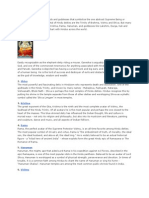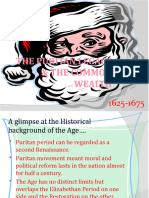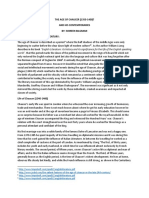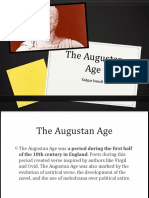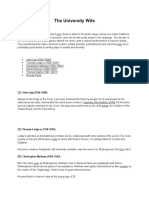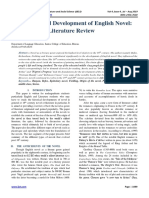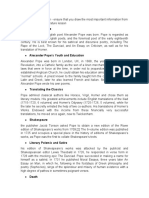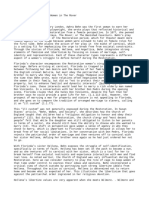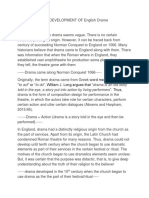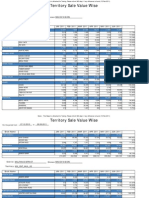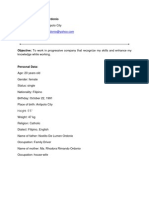English Prose in Renaissance
English Prose in Renaissance
Uploaded by
Muhammad YahyaCopyright:
Available Formats
English Prose in Renaissance
English Prose in Renaissance
Uploaded by
Muhammad YahyaOriginal Description:
Copyright
Available Formats
Share this document
Did you find this document useful?
Is this content inappropriate?
Copyright:
Available Formats
English Prose in Renaissance
English Prose in Renaissance
Uploaded by
Muhammad YahyaCopyright:
Available Formats
English Prose in Renaissance
The prose of Renaissance age, though inferior to the contemporary poetry and drama, bears all the hallmarks of literary peak. The great writers of the era have all the highlights of Italian Renaissance like the novelty of thought, height of imagination, search for new truths, and the revival of Greek ideals. With the introduction of movable printing machine brought to England by William Caxton, the volume of prose print increased manifold. This genre always considered inferior from literary perspective was infact the same when viewed as a whole, because the bulk of prose in the sixteenth century was in the form of pamphlets, propaganda by Protestants and Catholics for their support during Reformation. However, there are a few literary genius who left their marks qualitatively on the contemporary literature.
Sir Thomas More: what has nature ever created more gentle, more sweet, and more happy than the genius of Thomas more, wrote Erasmus on his first visit to England. An epitome of an ideal renaissance figure, Sir Thomas More was the strongest of English voices on the political, social, and human fronts. Voicing against the king Henry VII attempt to increase the tax revenue, Thomas More exactly knew his boundary line which he never stepped over. Never calling Kings name directly More entered politics, but lost his poise only once which proved fatal as King Henry VIII imprisoned Mores father during his conflict against the Kings Reformative adventure. His Utopia though written in Latin, is a typical Italian inspiration inspired by the great Platos philosophy. Its a philosophical romance, a fanciful account of an ideal republic. His Edward V is the first example of good English according to Hallam.
Sir Walter Raleigh: A soldier, navigator, courtier, author wrote A History of the World during Prison. Other works are A Nymphs Reply, A Lie, On Sidney.
John Lyly: A courtier, a soldier, a poet, a knight the brilliant John Lylys Euphues; Anatomy of Wit is a prose romance with poetic expression and subtlety of thought. Lyly pioneered a new genre of Euphuism in English literature. Its subject was the adventures of a young man (Euphues) well-endowed by nature but not disciplined by education. Apparently, the hero is an Athenian and Naples is the town of temptation, but beneath the disguise Euphues is an Oxford undergraduate corrupted by Italianate society of London. Lyly cared little of the criticism launched against him, and stuck to his style as in 1580 he came up with Euphues and his England.
Sir Philip Sidney: Another remarkable man with an all-round genius was Sir Philip Sidney whose famous attempt in prose was his An Apologie for Poetriewhich defended poetry and poets in the same way as Aristotle did in his times.
Religious Prose: As mentioned earlier, the bulk of prose written in the age of Renaissance was religious in nature, sometimes serving the people with translations of the Bible, and at another merely abusing the teachings of opponents faith for propaganda. The pamphlets printed during the conflicts of Catholics and Protestants were in millions which developed a taste for the printed things though but did no practical good to the literary spirit of the age. However, the remarkable attempts in this respect are: The translation of the Bible in English byWilliam Tyndal Thomas Cranmers The Book of Common Prayers
Sir Francis Bacon: Bacons Essays titled as Novum Organum though in Latin, are considered the greatest attempt in prose literature of that age because of two reasons: first, it is the maiden introduction of French literary genre of Essay which became increasingly popular in the ages to follow; secondly, the philosophy presented in them reflects the true Renaissance freedom of thought infused by the Italian Renaissance philosopher, Machiavelli.
You might also like
- Orphic Hymns Grimoire - Sara MastrosDocument440 pagesOrphic Hymns Grimoire - Sara MastrosDouglas Mackenzie100% (4)
- Memorial For Appellants 2Document35 pagesMemorial For Appellants 2Faraz Ali100% (4)
- Top 10 Hindu GodsDocument2 pagesTop 10 Hindu GodsMsafiri Kafiri Nathan FrancisNo ratings yet
- Previous Years Question Answers (Upscpdf - Com)Document156 pagesPrevious Years Question Answers (Upscpdf - Com)Vivek Sugandh100% (1)
- Restoration Period - LiteratureDocument3 pagesRestoration Period - LiteratureVictoria DonghiNo ratings yet
- Restoration PeriodDocument5 pagesRestoration PeriodZahid HasanNo ratings yet
- History of English LiteratureDocument6 pagesHistory of English LiteratureKarthika DR100% (1)
- Age of John MiltonDocument2 pagesAge of John MiltonAly FahadNo ratings yet
- Restoration Drama and ProseDocument2 pagesRestoration Drama and Prosescarlett811100% (1)
- Alexander Pope-Important NotesDocument7 pagesAlexander Pope-Important NotesJannat MemonNo ratings yet
- Alexander PopeDocument4 pagesAlexander PopeBhanu RainaNo ratings yet
- Piers The PlowmanDocument4 pagesPiers The Plowmansudipto paulNo ratings yet
- The Puritan Age, 1620-16606081Document21 pagesThe Puritan Age, 1620-16606081Aryani ArsyadNo ratings yet
- Pre-Raphaelite Poetry: DR - Pem Prakash Pankaj Asst - Professor, English Dept Vanijya Mahavidyalaya, PU Mob-8210481859Document8 pagesPre-Raphaelite Poetry: DR - Pem Prakash Pankaj Asst - Professor, English Dept Vanijya Mahavidyalaya, PU Mob-8210481859Sandip KunduNo ratings yet
- The Age of TransitionDocument2 pagesThe Age of Transitionputudevi71No ratings yet
- Cavalier Poet - WikipediaDocument4 pagesCavalier Poet - Wikipediasa46851No ratings yet
- English Novel of The 18 AND 19 Century: Karahasanović ArnesaDocument44 pagesEnglish Novel of The 18 AND 19 Century: Karahasanović ArnesaArnesa Džulan100% (1)
- Metaphisical AgeDocument6 pagesMetaphisical AgeDavid KhanNo ratings yet
- Neo-Classicism and PopeDocument27 pagesNeo-Classicism and Popeeder_intriago67% (3)
- THE AGE OF CHAUCER (1350-1400) and His Contemporaries By: Shireen Bilgrami Background of The 14 CenturyDocument3 pagesTHE AGE OF CHAUCER (1350-1400) and His Contemporaries By: Shireen Bilgrami Background of The 14 Centurybushra mumtazNo ratings yet
- Literary Essay The University WitsDocument6 pagesLiterary Essay The University Witsgull skNo ratings yet
- The Caroline AgeDocument7 pagesThe Caroline Ageanime30181gNo ratings yet
- Romantic PeriodDocument4 pagesRomantic PeriodAbinaya RNo ratings yet
- Neoclassical PeriodDocument7 pagesNeoclassical PeriodAngelica ArroyoNo ratings yet
- Pamela or Virtue RewardedDocument80 pagesPamela or Virtue RewardedawtshfhdNo ratings yet
- Age of SensibilityDocument2 pagesAge of SensibilitySulfa RaisNo ratings yet
- History of English LiteratureDocument129 pagesHistory of English Literature王芊鹤100% (1)
- ENGLISH HISTORY (Romantic Age) - 1Document4 pagesENGLISH HISTORY (Romantic Age) - 1Bhumit ChudasamaNo ratings yet
- 3 - The Decline of Feudalism in The Middle Ages - The Age of ChaucerDocument3 pages3 - The Decline of Feudalism in The Middle Ages - The Age of ChaucerOry Belliu100% (1)
- Renaissance Q3 NotesDocument9 pagesRenaissance Q3 NotesFrank Ed Serrano100% (1)
- History BS Literature 2nd Semester (2018)Document33 pagesHistory BS Literature 2nd Semester (2018)IqraNo ratings yet
- Alexander PopeDocument2 pagesAlexander Popenatura200No ratings yet
- The Origin and Rise of NovelDocument7 pagesThe Origin and Rise of NovelMaida KhanNo ratings yet
- 17th Century Poetry (Cavalier and Metaphysical Poets)Document2 pages17th Century Poetry (Cavalier and Metaphysical Poets)Omnia Othman100% (1)
- The Shoemaker's HolidayDocument22 pagesThe Shoemaker's HolidayIllıllı AMAZING SPIDER MAN IllıllıNo ratings yet
- The Augustan AgeDocument20 pagesThe Augustan AgeHoshear Sdeq JamelNo ratings yet
- The Age of Milton and Its Influence On His Life and Works - NeoEnglishDocument3 pagesThe Age of Milton and Its Influence On His Life and Works - NeoEnglishNiKsse100% (1)
- Evaluate Tennyson, Browning and Mathew Arnold As The Representative Poets of The Victorian AgeDocument3 pagesEvaluate Tennyson, Browning and Mathew Arnold As The Representative Poets of The Victorian AgePriyanka DasNo ratings yet
- The Gothic Novel: Novelists of The Romantic AgeDocument2 pagesThe Gothic Novel: Novelists of The Romantic AgeIntezar Lahasil0% (1)
- Henry FieldingDocument4 pagesHenry FieldingSahir Khan0% (1)
- Poets of Romanric AgeDocument53 pagesPoets of Romanric AgeAbdullah ShahidNo ratings yet
- Augustan AgeDocument35 pagesAugustan AgeLify BlessyNo ratings yet
- Elizabethan PoetryDocument2 pagesElizabethan Poetrymughalhafeez443No ratings yet
- DRAMA B.A 3rd Sem Different Kinds of Drama Not Immp NowDocument33 pagesDRAMA B.A 3rd Sem Different Kinds of Drama Not Immp NowrameenNo ratings yet
- The-Prelude NotesDocument5 pagesThe-Prelude Notesmanasvi100% (1)
- ImagismDocument2 pagesImagismTahirullah KhanNo ratings yet
- University WitsDocument3 pagesUniversity WitsSAHIN AKHTAR100% (1)
- Depth Discussion Preface To ShakespeoreDocument7 pagesDepth Discussion Preface To ShakespeoreBirojit DasNo ratings yet
- Brief History of English and American LitDocument49 pagesBrief History of English and American LitNaneth Domen100% (1)
- 11.1 The RomanticismDocument5 pages11.1 The RomanticismHaron Waweru (Engineer Waweru)No ratings yet
- The Restoration Period (1660-1700) : The Important Facts Which Influenced The Literature of This Period AreDocument6 pagesThe Restoration Period (1660-1700) : The Important Facts Which Influenced The Literature of This Period AreKiều TrinhNo ratings yet
- Eighteenth Century Periodical EssayDocument5 pagesEighteenth Century Periodical Essaynirmalmahata098No ratings yet
- The Origin and Development of English Novel: A Descriptive Literature ReviewDocument6 pagesThe Origin and Development of English Novel: A Descriptive Literature ReviewIJELS Research JournalNo ratings yet
- Renaissance DramaDocument36 pagesRenaissance DramaAmalia Ramírez AranaNo ratings yet
- Alexander PopeDocument2 pagesAlexander PopeEdwin ValdésNo ratings yet
- English Literature Project On Shakespeare's Literary Background and Achievements During Elizabethan AgeDocument6 pagesEnglish Literature Project On Shakespeare's Literary Background and Achievements During Elizabethan AgeSanjampreet Singh100% (1)
- Portrayal of Restoration Women in TDocument6 pagesPortrayal of Restoration Women in TSaatvika Maulihar BA p 1stNo ratings yet
- Romantic Writers and Their WorksDocument27 pagesRomantic Writers and Their Worksghulammujtaba1266No ratings yet
- History of NovelsDocument3 pagesHistory of NovelsImran Shaikh100% (1)
- The Development of English DramaDocument6 pagesThe Development of English Dramamarrylfa hamNo ratings yet
- The Rape of The Lock As A Satire On TheDocument37 pagesThe Rape of The Lock As A Satire On TheTayyab Khan MarwatNo ratings yet
- Allama Iqbal Open University, Islamabad: Assignment No. 1 (Units 1-4)Document2 pagesAllama Iqbal Open University, Islamabad: Assignment No. 1 (Units 1-4)Muhammad YahyaNo ratings yet
- Mul Max Unit Wise 27-12-2010 To 26-06-2011Document59 pagesMul Max Unit Wise 27-12-2010 To 26-06-2011Muhammad YahyaNo ratings yet
- Territory Sale Value Wise: Max Division Divison: Multan District District: MX - CNT - MUL - 01 TerritoryDocument7 pagesTerritory Sale Value Wise: Max Division Divison: Multan District District: MX - CNT - MUL - 01 TerritoryMuhammad YahyaNo ratings yet
- FSD Max Unit Wise 27-06-2011 To 26-12-2011Document46 pagesFSD Max Unit Wise 27-06-2011 To 26-12-2011Muhammad YahyaNo ratings yet
- The Dying Sun Short QuestionsDocument4 pagesThe Dying Sun Short QuestionsMuhammad Yahya0% (3)
- Banaras Hindu University - National Conference - 2024Document2 pagesBanaras Hindu University - National Conference - 2024Khushman AggarwalNo ratings yet
- Culture and Religion: An Interdisciplinary JournalDocument16 pagesCulture and Religion: An Interdisciplinary JournalYamil Escaffi ANo ratings yet
- Shakta UpanishadsDocument1 pageShakta Upanishadsvinod reddyNo ratings yet
- 200 Golden Hadith-1Document43 pages200 Golden Hadith-1Zakaria ShenwariNo ratings yet
- Badami Cave Temples - WikipediaDocument13 pagesBadami Cave Temples - WikipediaPaul PNo ratings yet
- Desolate Era-Part 1Document3 pagesDesolate Era-Part 1João Pedro FariasNo ratings yet
- Greek Coinage / N.K. RutterDocument56 pagesGreek Coinage / N.K. RutterDigital Library Numis (DLN)100% (1)
- Hauerwas Speaking ChristianDocument11 pagesHauerwas Speaking ChristianlittlebrothersofjesusnigNo ratings yet
- Soal TOEFL Latihan Ke-1Document5 pagesSoal TOEFL Latihan Ke-1ayu lestariNo ratings yet
- Chapter Nine The Journey On : Author's Note: This Is The Only Chapter That Is Very Significantly Out of Date. It DealsDocument4 pagesChapter Nine The Journey On : Author's Note: This Is The Only Chapter That Is Very Significantly Out of Date. It DealsKrestaNo ratings yet
- The Self As A Social Construct: The Self in The Western and Oriental Thought IndividualismDocument5 pagesThe Self As A Social Construct: The Self in The Western and Oriental Thought IndividualismStef FieNo ratings yet
- Don JuanDocument419 pagesDon Juaneliza.cunha.140No ratings yet
- AvbookDocument227 pagesAvbooksaurnihaNo ratings yet
- Bertrand Russell On Critical ThinkingDocument6 pagesBertrand Russell On Critical ThinkingErica CalzadaNo ratings yet
- President Vaclav Havel Acceptance SpeechDocument4 pagesPresident Vaclav Havel Acceptance SpeechCzarPaguioNo ratings yet
- Rana Digest - PropertyDocument6 pagesRana Digest - PropertyZiazel ThereseNo ratings yet
- Indian ContributionsDocument4 pagesIndian ContributionsReetu RajNo ratings yet
- Offerings Chart BDocument2 pagesOfferings Chart BRODNEY TANNo ratings yet
- Deepak ChopraDocument5 pagesDeepak ChopraCatherine EscartinNo ratings yet
- Consequences of Agent's ContractDocument26 pagesConsequences of Agent's ContractRicha Raj100% (1)
- Yellow CrucifixionDocument15 pagesYellow Crucifixionapi-610394285No ratings yet
- From Chögyam Trungpa 'S The Truth of Suffering and The Path of Liberation, Pp. 117-118Document1 pageFrom Chögyam Trungpa 'S The Truth of Suffering and The Path of Liberation, Pp. 117-118Proxy's AppealNo ratings yet
- Van Hooft - Review of Emmanuel Levinas, Humanism of The Other - 2004Document7 pagesVan Hooft - Review of Emmanuel Levinas, Humanism of The Other - 2004ericrustadNo ratings yet
- Section 1 (Easy)Document44 pagesSection 1 (Easy)Hassaan AzizNo ratings yet
- Rhodwelyn Rimando OrdonioDocument17 pagesRhodwelyn Rimando OrdonioMichelle MancolNo ratings yet
- 284-Article Text-446-1-10-20181225Document17 pages284-Article Text-446-1-10-20181225Hamid RosyidilNo ratings yet


